Experimental Investigation of the Natural Bonding Strength between Stay-In-Place Form and Concrete in FRP-Concrete Decks/Beams
Abstract
:Featured Application
Abstract
1. Introduction
2. Experimental Determination of FRP-Concrete Natural Bonding by the Push-Out Test
2.1. Material Properties and Setup of the Push-Out Test
2.2. Experimental Observations of the Push-Out Test
3. Comparative Flexural Test of FRP-Concrete Hybrid Beam
3.1. Material Properties and Setup for the Flexural Test
3.2. Test Observations of the Two Beams
3.3. The Influence of the Brittle Failure of Natural Bonding
4. Modeling the Flexural Rigidity Considering Natural Bonding Effect
5. Conclusions
Author Contributions
Funding
Acknowledgments
Conflicts of Interest
References
- Bakis, C.E.; Bank, L.C.; Brown, V.; Cosenza, E.; Davalos, J.F.; Lesko, J.J.; Machida, A.; Rizkalla, S.H.; Triantafillou, T.C. Fiber-reinforced polymer composites for construction—State-of-the-art review. J. Compos. Constr. 2002, 6, 73–87. [Google Scholar] [CrossRef]
- Jiang, C.; Wu, Y.F.; Wu, G. Plastic hinge length of FRP-confined square RC columns. J. Compos. Constr. 2014, 18, 04014003. [Google Scholar] [CrossRef]
- Wu, Y.F.; Jiang, C. Quantification of bond-slip relationship for externally bonded FRP-to-concrete joints. J. Compos. Constr. 2013, 17, 673–686. [Google Scholar] [CrossRef]
- Antonopoulos, C.P.; Triantafillou, T.C. Analysis of FRP-strengthened RC beam-column joints. J. Compos. Constr. 2002, 6, 41–51. [Google Scholar] [CrossRef]
- Cascardi, A.; Micelli, F.; Aiello, M.A. Unified model for hollow columns externally confined by FRP. Eng. Struct. 2016, 111, 119–130. [Google Scholar] [CrossRef]
- Banthia, N.; Abdolrahimzadeh, A.; Demers, M.; Mufti, A.; Sheikh, S. Durability of FRP-concrete bond in FRP-strengthened bridges. Concr. Int. 2010, 32, 45–51. [Google Scholar]
- Valluzzi, M.R.; Modena, C.; de Felice, G. Current practice and open issues in strengthening historical buildings with composites. Mater. Struct. 2014, 47, 1971–1985. [Google Scholar] [CrossRef]
- Liu, F.; Wu, B.; Wei, D. Failure modes of reinforced concrete beams strengthened with carbon fiber sheet in fire. Fire Saf. J. 2009, 44, 941–950. [Google Scholar] [CrossRef]
- Zheng, Y.; Yu, G.; Pan, Y. Investigation of ultimate strengths of concrete bridge deck slabs reinforced with GFRP bars. Constr. Build. Mater. 2012, 28, 482–492. [Google Scholar] [CrossRef]
- Zheng, Y.; Li, C.; Yu, G. Investigation of structural behaviours of laterally restrained GFRP reinforced concrete slabs. Compos. Part B Eng. 2012, 43, 1586–1597. [Google Scholar] [CrossRef]
- Li, W.; Ho, S.C.M.; Patil, D.; Song, G. Acoustic emission monitoring and finite element analysis of debonding in fiber-reinforced polymer rebar reinforced concrete. Struct. Health Monit. 2017, 16, 674–681. [Google Scholar] [CrossRef]
- Zhu, C.; Chen, Y.; Zhuang, Y.; Du, Y.; Gerald, R.E.; Tang, Y.; Huang, J. An optical interferometric triaxial displacement sensor for structural health monitoring: Characterization of sliding and debonding for a delamination process. Sensors 2017, 17, 2696. [Google Scholar] [CrossRef] [PubMed]
- Kumar, P.; Chandrashekhara, K.; Nanni, A. Structural performance of a FRP bridge deck. Constr. Build. Mater. 2004, 18, 35–47. [Google Scholar] [CrossRef]
- Alagusundaramoorthy, P.; Harik, I.E.; Choo, C.C. Structural behavior of FRP composite bridge deck panels. J. Bridge Eng. 2006, 11, 384–393. [Google Scholar] [CrossRef]
- Keller, T.; Bai, Y.; Vallée, T. Long-term performance of a glass fiber-reinforced polymer truss bridge. J. Compos. Constr. 2007, 11, 99–108. [Google Scholar] [CrossRef]
- Li, Y.F.; Hsu, T.H.; Hsieh, F.C. A Study on Improving the Mechanical Behaviors of the Pultruded GFRP Composite Material Members. Sustainability 2019, 11, 577. [Google Scholar] [CrossRef]
- Keller, T. Recent all-composite and hybrid fibre-reinforced polymer bridges and buildings. Prog. Struct. Eng. Mater. 2001, 3, 132–140. [Google Scholar] [CrossRef]
- Ulloa, F.; Medlock, R.; Ziehl, P.; Fowler, T. A hybrid FRP bridge for Texas. Concr. Int. 2004, 26, 38–43. [Google Scholar]
- Alachek, I.; Reboul, N.; Jurkiewiez, B. Experimental and finite element analysis of the long-term behaviour of GFRP-concrete hybrid beams fabricated using adhesive bonding. Compos. Struct. 2019, 207, 148–165. [Google Scholar] [CrossRef]
- Gonilha, J.A.; Correia, J.R.; Branco, F.A.; Sena-Cruz, J. Durability of GFRP-concrete adhesively bonded connections: Experimental and numerical studies. Eng. Struct. 2018, 168, 784–798. [Google Scholar] [CrossRef]
- Siwowski, T.; Kulpa, M.; Rajchel, M.; Poneta, P. Design, manufacturing and structural testing of all-composite FRP bridge girder. Compos. Struct. 2018, 206, 814–827. [Google Scholar] [CrossRef]
- Siwowski, T.; Kaleta, D.; Rajchel, M. Structural behaviour of an all-composite road bridge. Compos. Struct. 2018, 192, 555–567. [Google Scholar] [CrossRef]
- Zhang, S.; Xue, W.C.; Liao, X. Theoretical analysis on long-term deflection of GFRP-concrete hybrid structure with partial interaction. Compos. Struct. 2019. [Google Scholar] [CrossRef]
- Mieres, J.M.; Calvo, I.; Miravete, A.; Gutiérrez, E.; Shahidi, E.; López, C.; Cuartero, J.; Comino, P.; de Villoria, R.G. Description of a traffic bridge of the Cantabrian SpeedWay made of composite materials. Mater. Construcción 2006, 56, 81–86. [Google Scholar]
- Nystrom, H.E.; Watkins, S.E.; Nanni, A.; Murray, S. Financial viability of fiber-reinforced polymer (FRP) bridges. J. Manag. Eng. 2003, 19, 2–8. [Google Scholar] [CrossRef]
- Berg, A.C.; Bank, L.C.; Oliva, M.G.; Russell, J.S. Construction and cost analysis of an FRP reinforced concrete bridge deck. Constr. Build. Mater. 2006, 20, 515–526. [Google Scholar] [CrossRef]
- Hastak, M.; Halpin, D.W. Assessment of life-cycle benefit-cost of composites in construction. J. Compos. Constr. 2000, 4, 103–111. [Google Scholar] [CrossRef]
- Zou, X.; Feng, P.; Wang, J. Perforated FRP ribs for shear connecting of FRP-concrete hybrid beams/decks. Compos. Struct. 2016, 152, 267–276. [Google Scholar] [CrossRef]
- Zou, X.; Feng, P.; Wang, J.; Wu, Y.; Feng, Y. FRP stay-in-place form and shear key connection for FRP-concrete hybrid beams/decks. Compos. Struct. 2018, 192, 489–499. [Google Scholar] [CrossRef]
- Zou, X.; Feng, P.; Wang, J. Bolted Shear Connection of FRP-Concrete Hybrid Beams. J. Compos. Constr. 2018, 22, 04018012. [Google Scholar] [CrossRef]
- Nguyen, H.; Mutsuyoshi, H.; Zatar, W. Push-out tests for shear connections between UHPFRC slabs and FRP girder. Compos. Struct. 2014, 118, 528–547. [Google Scholar] [CrossRef]
- Saiidi, M.; Gordaninejad, F.; Wehbe, N. Behavior of graphite/epoxy concrete composite beams. J. Struct. Eng. 1994, 120, 2958–2976. [Google Scholar] [CrossRef]
- Cho, K.; Park, S.Y.; Kim, S.T.; Cho, J.R.; Kim, B.S. Shear connection system and performance evaluation of FRP-concrete composite deck. KSCE J. Civ. Eng. 2010, 14, 855–865. [Google Scholar] [CrossRef]
- Zhang, P.; Wu, G.; Zhu, H.; Meng, S.P.; Wu, Z.S. Mechanical performance of the wet-bond interface between FRP plates and cast-in-place concrete. J. Compos. Constr. 2014, 18, 04014016. [Google Scholar] [CrossRef]
- Deskovic, N.; Triantafillou, T.C.; Meier, U. Innovative design of FRP combined with concrete: Short-term behavior. J. Struct. Eng. 1995, 121, 1069–1078. [Google Scholar] [CrossRef]
- Mendes, P.J.; Barros, J.A.; Sena-Cruz, J.M.; Taheri, M. Development of a pedestrian bridge with GFRP profiles and fiber reinforced self-compacting concrete deck. Compos. Struct. 2011, 93, 2969–2982. [Google Scholar] [CrossRef]
- Zheng, Y.; Taylor, S.; Robinson, D.; Cleland, D. Investigation of ultimate strength of deck slabs in steel-concrete bridges. Aci Struct. J. 2010, 107, 82–91. [Google Scholar]
- Gong, J.; Zou, X.; Shi, H.; Jiang, C.; Li, Z. Numerical Investigation of the Nonlinear Composite Action of FRP-Concrete Hybrid Beams/Decks. Appl. Sci. 2018, 8, 2031. [Google Scholar] [CrossRef]
- Mendes, P.J.; Barros, J.A.; Sena-Cruz, J.; Teheri, M. Influence of fatigue and aggressive exposure on GFRP girder to SFRSCC deck all-adhesive connection. Compos. Struct. 2014, 110, 152–162. [Google Scholar] [CrossRef] [Green Version]
- Gonilha, J.A.; Barros, J.; Correia, J.R.; Sena-Cruz, J.; Branco, F.A.; Ramos, L.F.; Santos, T. Static, dynamic and creep behaviour of a full-scale GFRP-SFRSCC hybrid footbridge. Compos. Struct. 2014, 118, 496–509. [Google Scholar] [CrossRef] [Green Version]
- Alachek, I.; Reboul, N.; Jurkiewiez, B. Long-time behaviour of GFRP/concrete hybrid structures. In Proceedings of the 9th International Conference on Fibre-Reinforced Polymer (FRP) Composites in Civil Engineering (CICE 2018), Paris, France, 17–19 July 2018. [Google Scholar]
- Yuan, J.S.; Hadi, M.N. Bond-slip behaviour between GFRP I-section and concrete. Compos. Part B Eng. 2017, 130, 76–89. [Google Scholar] [CrossRef]
- Noël, M.; Fam, A. Design equations for concrete bridge decks with FRP stay-in-place structural forms. J. Compos. Constr. 2016, 20, 04016024. [Google Scholar] [CrossRef]
- Correia, J.R.; Branco, F.A.; João, G.F. Flexural behaviour of multi-span GFRP-concrete hybrid beams. Eng. Struct. 2009, 31, 1369–1381. [Google Scholar] [CrossRef]

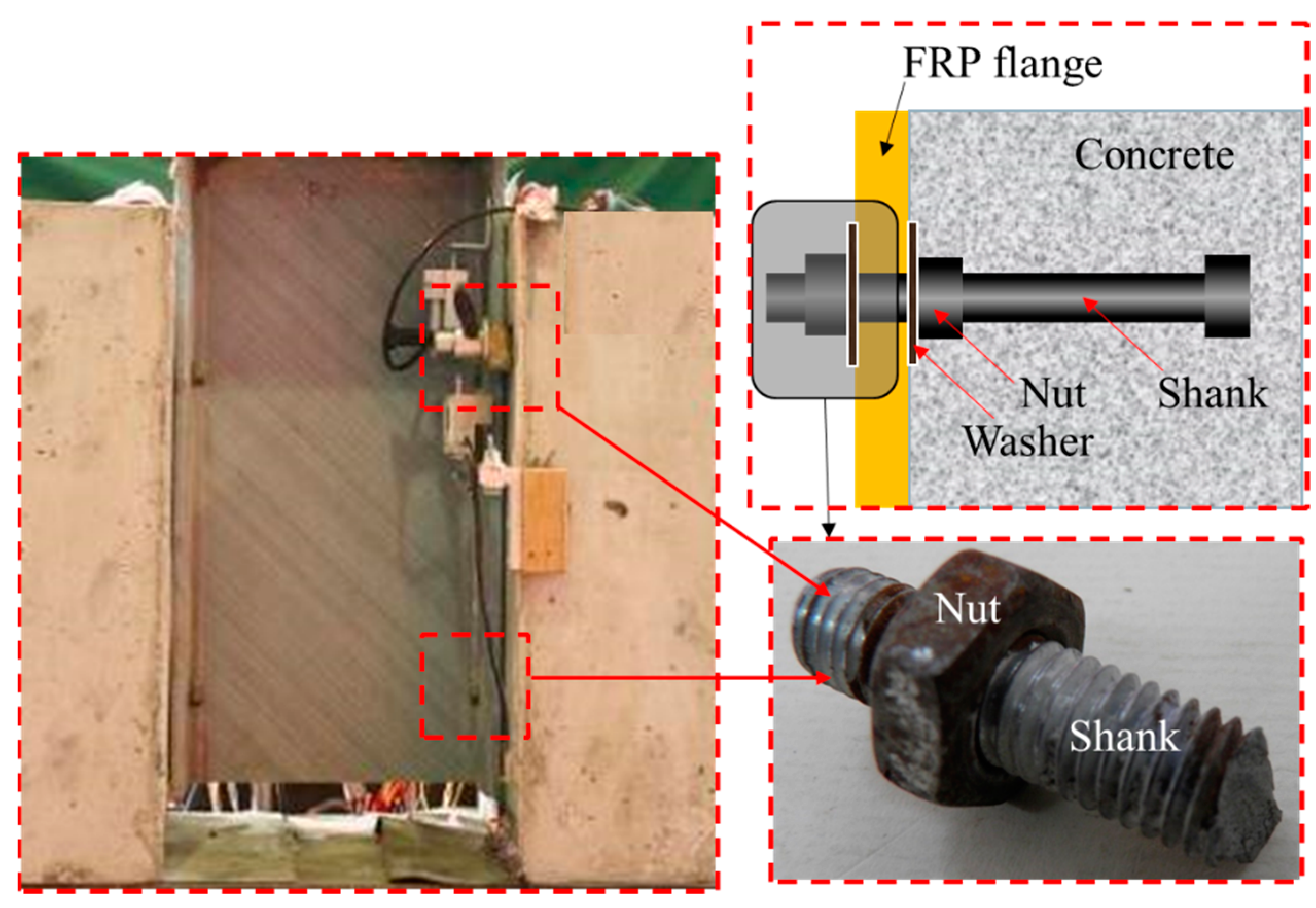

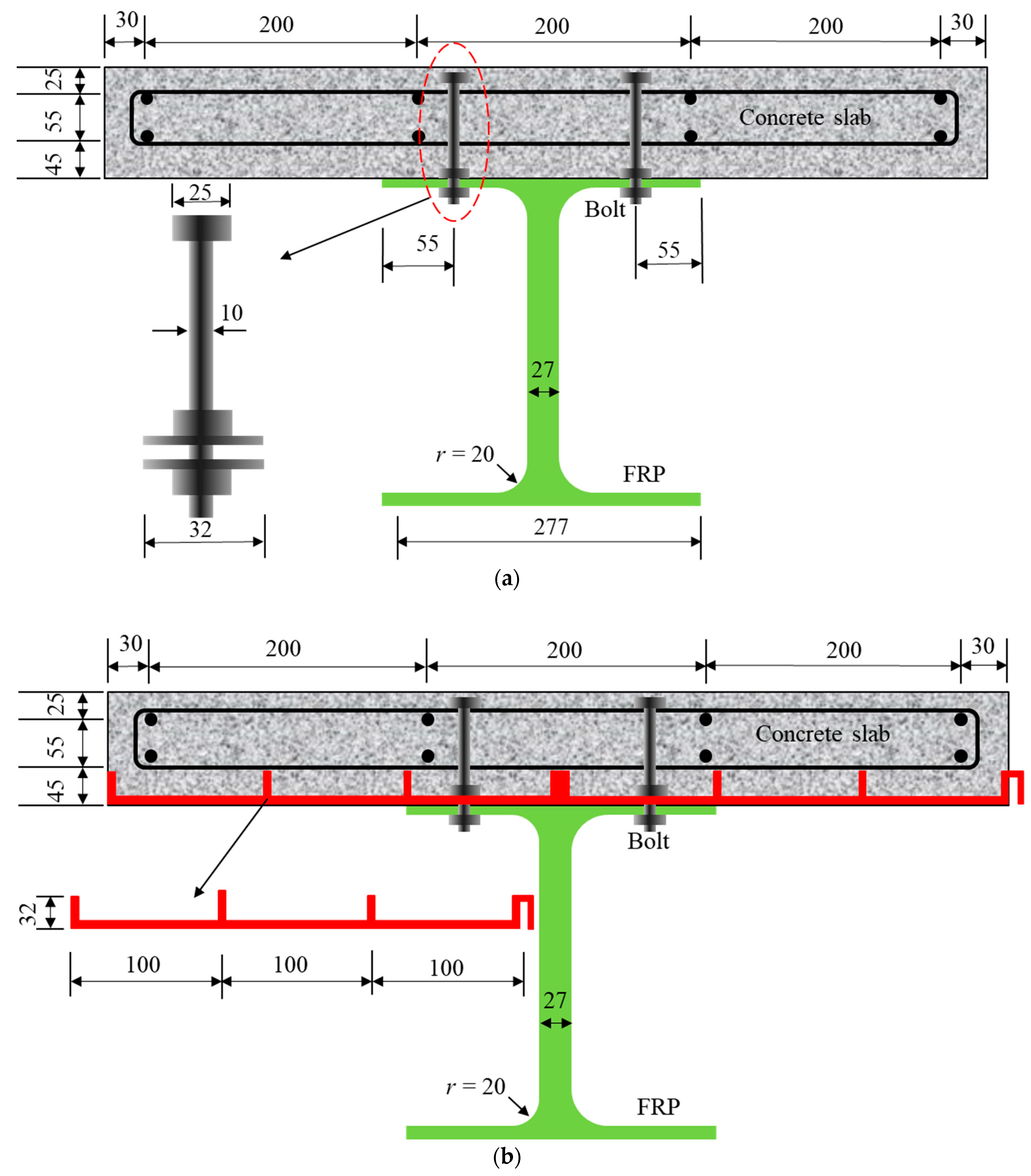
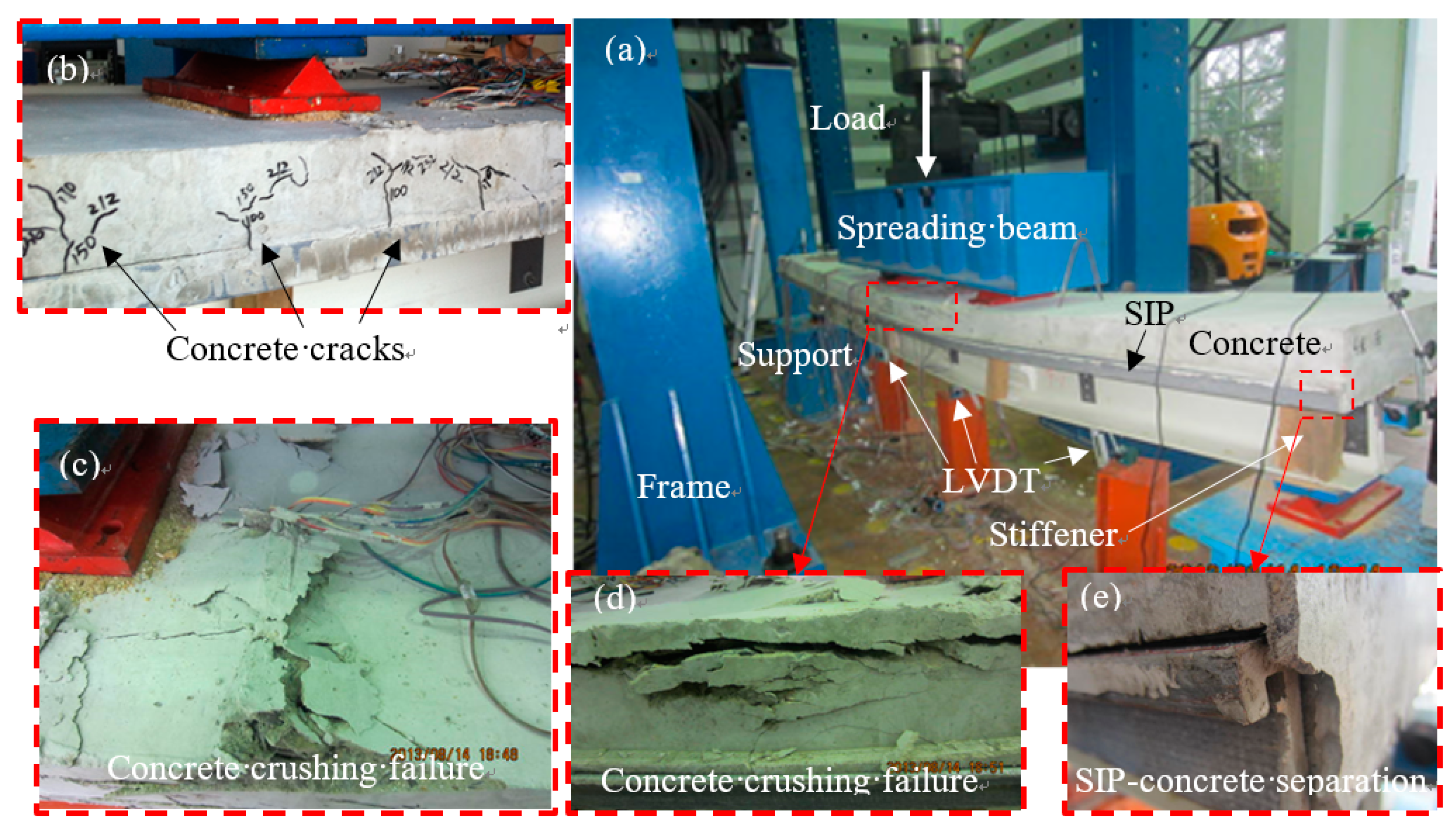
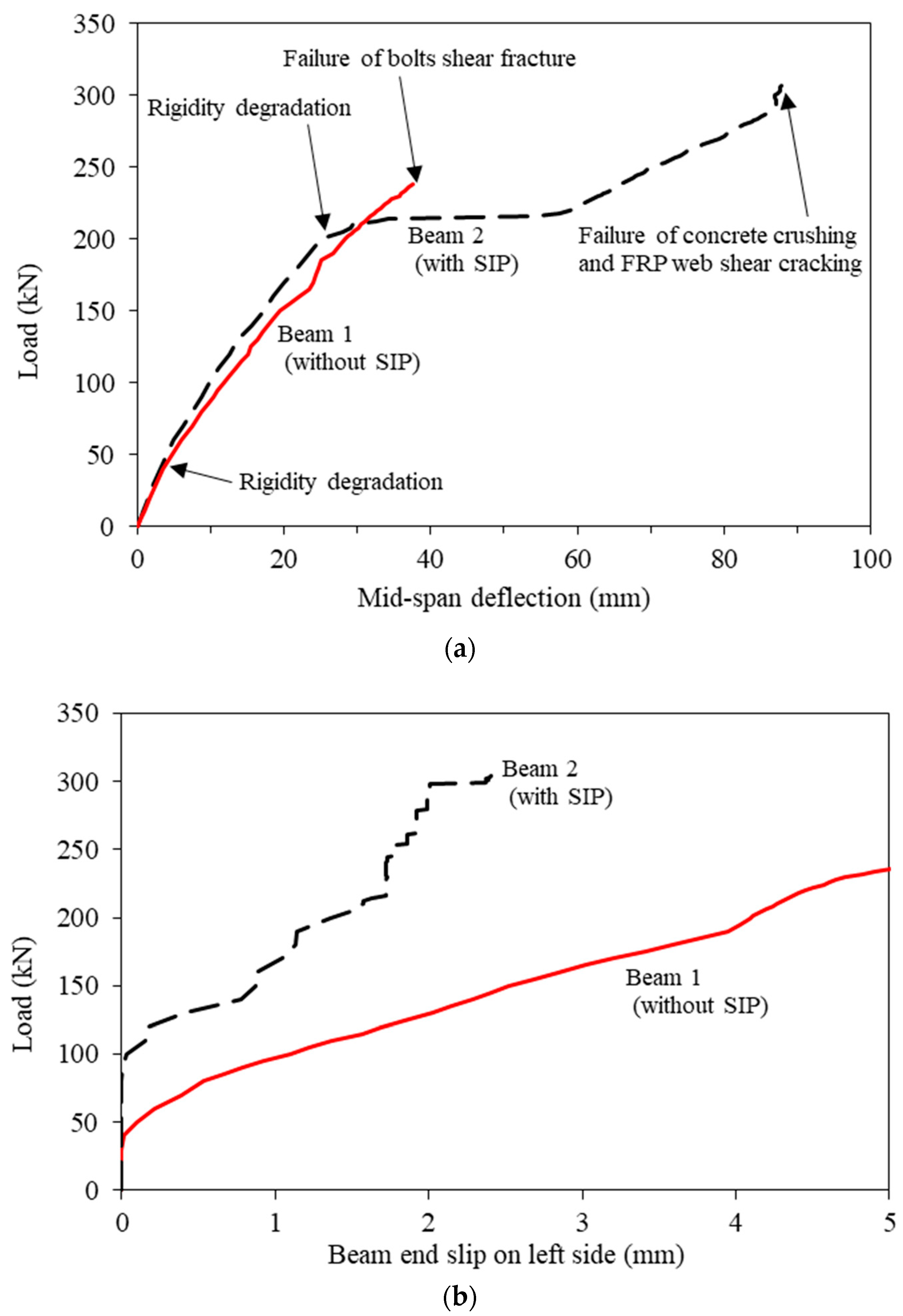
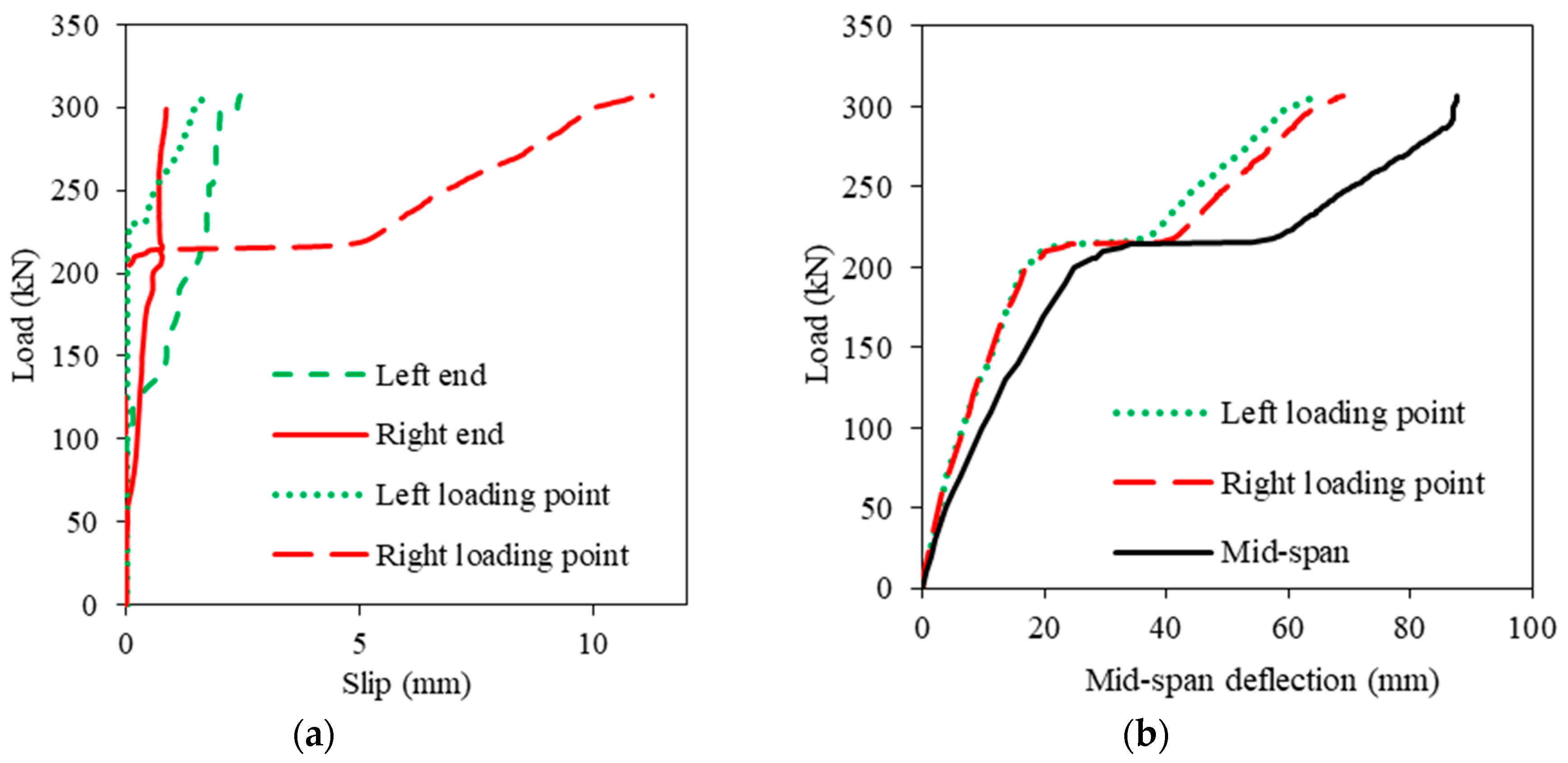

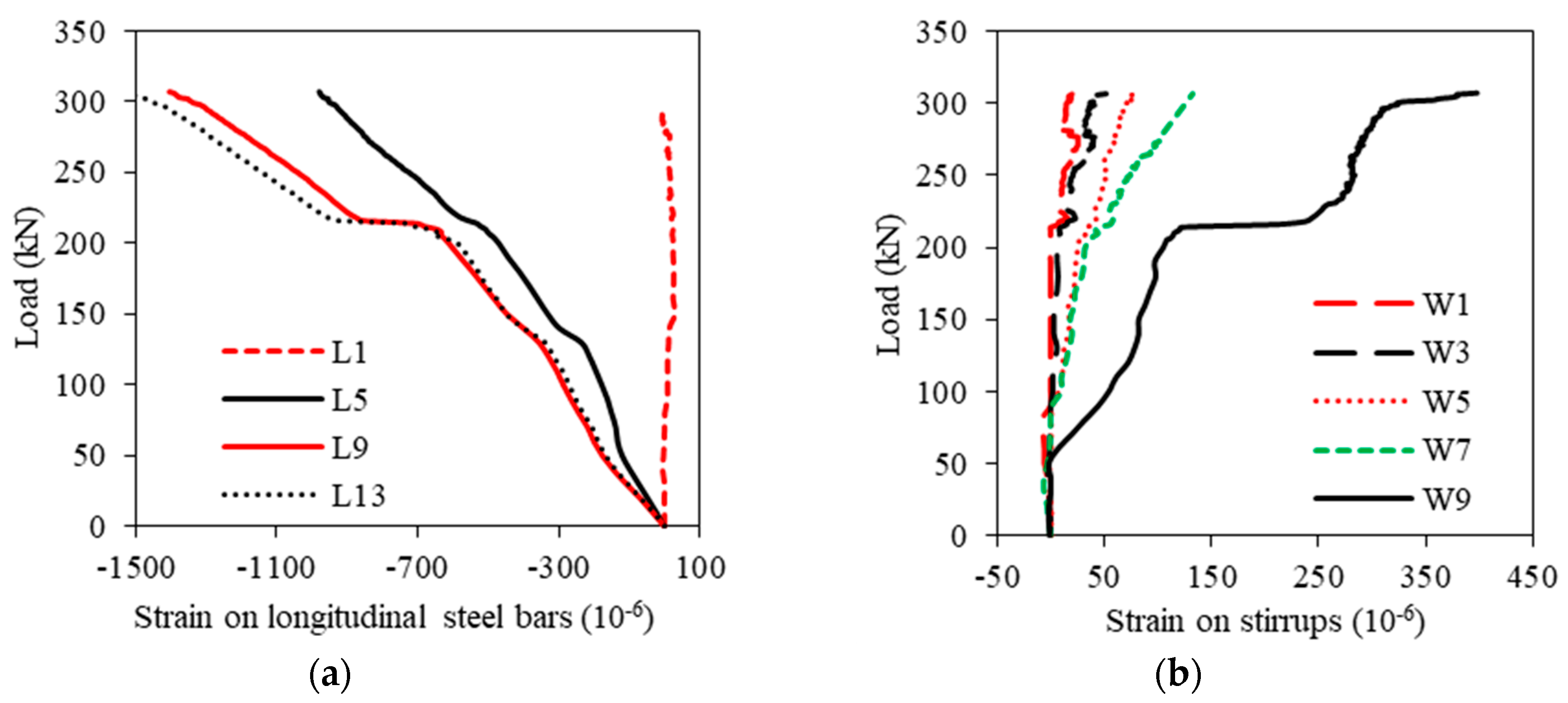

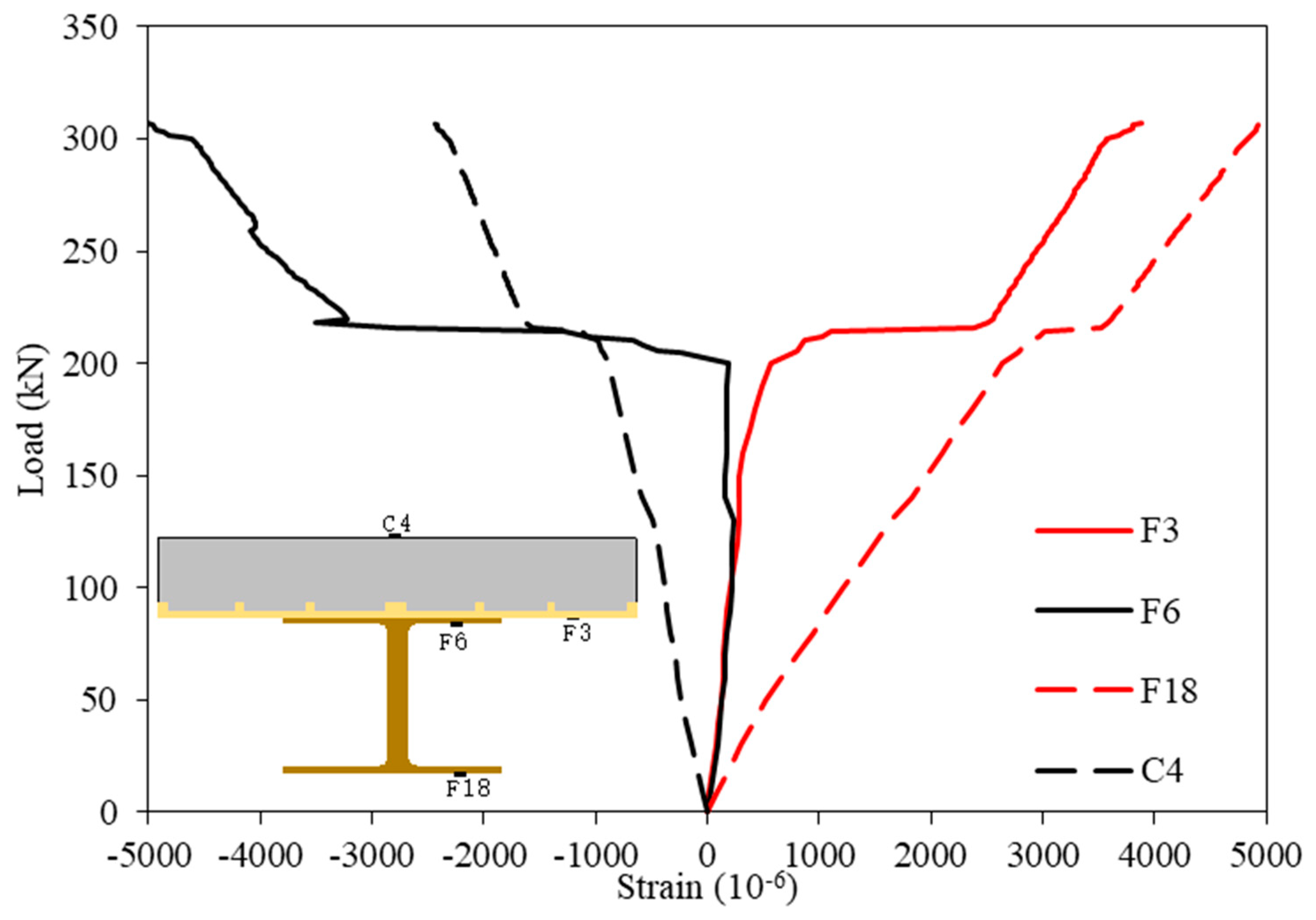
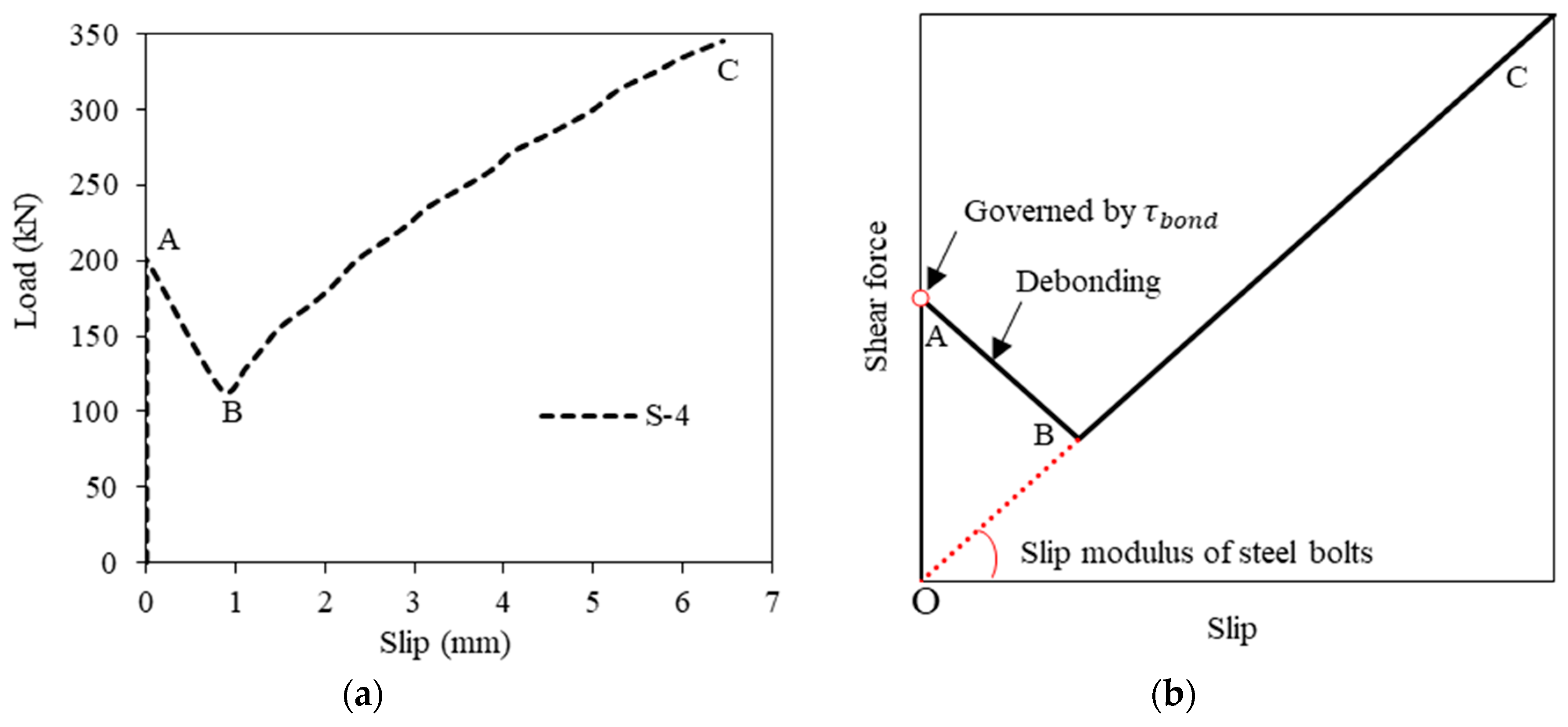
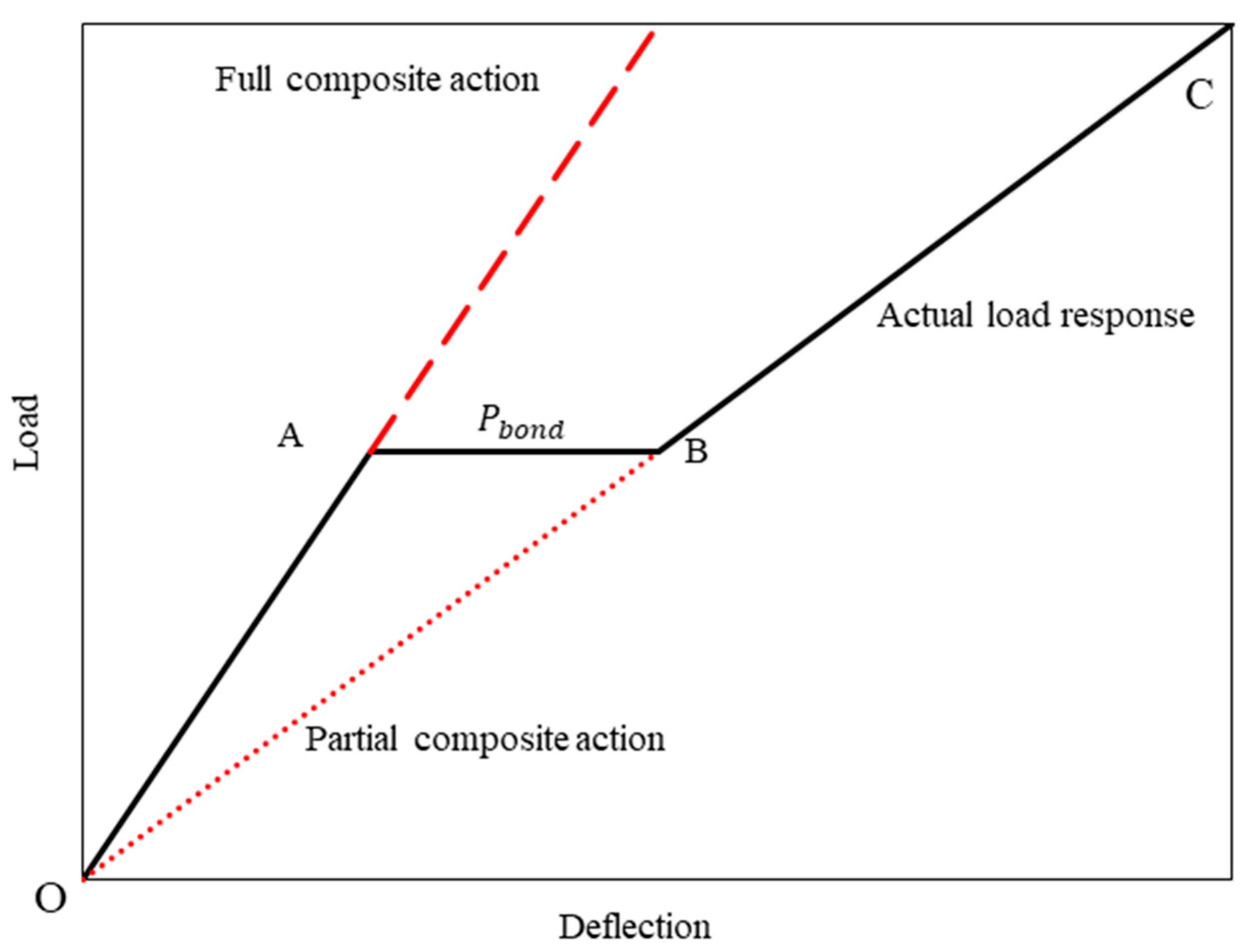
| Specimen Code | Type of Connection | Spacing of Bolts (mm) | Bolt Number | |||
|---|---|---|---|---|---|---|
| S-1 | Steel bolts | 150 | 8 | 205 | 5.54 | 25.63 |
| S-2 | Steel bolts | 100 | 12 | 300 | 4.58 | 25.00 |
| S-3 | Steel bolts & SIP | 150 | 8 | 220 | 4.61 | 27.50 |
| S-4 | Steel bolts & SIP | 100 | 12 | 345 | 6.45 | 28.75 |
| Longitudinal Tensile Strength | Longitudinal Tensile Modulus | Longitudinal Compressive Strength | Longitudinal Compressive Modulus | Shear Strength | |
|---|---|---|---|---|---|
| FRP girder | 420 MPa | 25 GPa | 350 MPa | 13 GPa | 11.8 MPa |
| SIP forms | 390 MPa | 22 GPa | 350 MPa | 12 GPa | 13.5 MPa |
| Specimen | Non-Slip Stage | Debonding Stage | Bearing Stage | |||
|---|---|---|---|---|---|---|
| Load (kN) | Slip (mm) | Load (kN) | Slip (mm) | Load (kN) | Slip (mm) | |
| S-3 | 184 | 0 | 101 | 1.08 | 220 | 4.61 |
| S-4 | 200 | 0 | 114 | 0.84 | 345 | 6.45 |
© 2019 by the authors. Licensee MDPI, Basel, Switzerland. This article is an open access article distributed under the terms and conditions of the Creative Commons Attribution (CC BY) license (http://creativecommons.org/licenses/by/4.0/).
Share and Cite
Gong, J.; Zou, X.; Xia, P. Experimental Investigation of the Natural Bonding Strength between Stay-In-Place Form and Concrete in FRP-Concrete Decks/Beams. Appl. Sci. 2019, 9, 913. https://doi.org/10.3390/app9050913
Gong J, Zou X, Xia P. Experimental Investigation of the Natural Bonding Strength between Stay-In-Place Form and Concrete in FRP-Concrete Decks/Beams. Applied Sciences. 2019; 9(5):913. https://doi.org/10.3390/app9050913
Chicago/Turabian StyleGong, Jianwu, Xingxing Zou, and Ping Xia. 2019. "Experimental Investigation of the Natural Bonding Strength between Stay-In-Place Form and Concrete in FRP-Concrete Decks/Beams" Applied Sciences 9, no. 5: 913. https://doi.org/10.3390/app9050913






